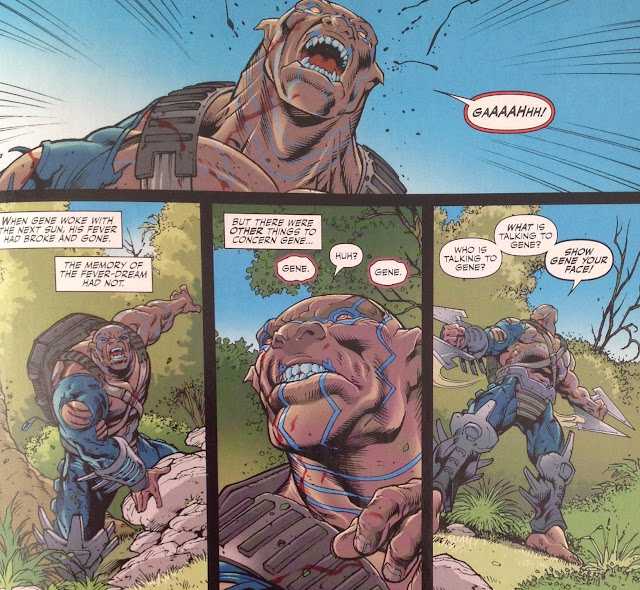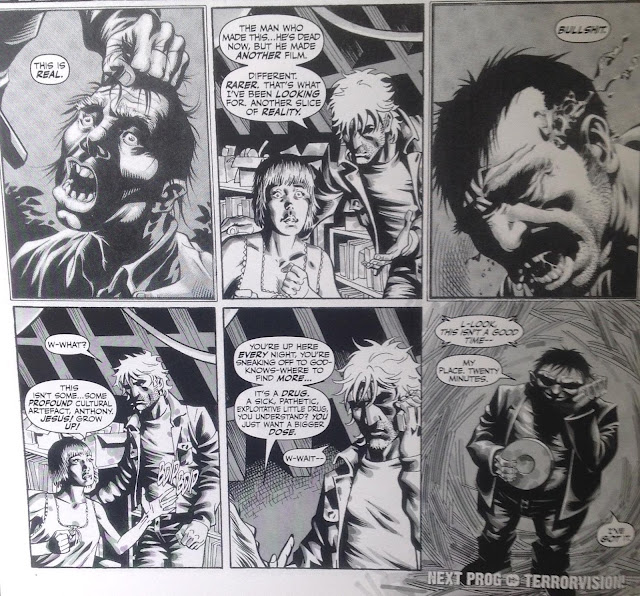First Prog: 564
Latest Prog: 1909 –
with more Kingdom to come, at the
very least.
First Meg: 3.69
(aka 172)
Latest Meg: 242 (on the cover); on the inside 4.12 (aka 194) – a very long time ago, but no reason why he won’t appear in its pages again one day.
Latest Meg: 242 (on the cover); on the inside 4.12 (aka 194) – a very long time ago, but no reason why he won’t appear in its pages again one day.
Total appearances: 197 and counting
-including a fair handful of
colouring work on top of other artists.
Creator credits:
Shadows; Roadkill; Atavar;
A.H.A.B.; The Scrap; Kingdom; Marauder; Go Machine
Other art credits:
Judge Dredd
Tyranny Rex
Maniac 5
Maniac 5
Rogue Trooper
A handful of Future Shocks
Notable character creations:
It’s hard to look past the
awesomeness of Gene the Hackman, but before that there was:
The unnamed Atavar and the
various alien / AI creatures he encountered
Captain Ahab and his space whale (obviously the ‘character’ is Herman Melville’s really, but Elson did a bang-up job of designing this Space Opera variant!)
Captain Ahab and his space whale (obviously the ‘character’ is Herman Melville’s really, but Elson did a bang-up job of designing this Space Opera variant!)
The Lawlords, sometime enemies
of Judge Dredd
Notable characteristics:
Fun; bright colours;
snarls; action, action, action; looks of stark terror.
On Richard:
Richard Elson got his
start with 2000 AD rather a long time ago, in the usual way, with a handful of Future Shocks and then a one-off series,
Shadows. In some ways his art was a
little rough around the edges, but I rather liked it, it was a pretty neat
contrast to some of the other artists of the day (coughSimonBisleycough), not least the vibrant colours (some of
which were produced by Elson himself, but also Tim Perkins). He had some crazy
hairstyles going.
 |
| The Shadows of the title are the underclass - people living in slums, basically. Words by Peter Milligan |
 |
| Definite Matrix vibe going on (some 10 years before the movei, mind!) Words by Peter Milligan |
I didn’t notice it at
the time, but I get the distinct impression now that he was following hard in
the footsteps of art legend Brendan McCarthy. Check out these two Elson star
scans, one from his early days…
and one from more
recently, celebrating a Dredd episode that you’d have to say Elson chose to
draw, rather than being commissioned.*
For who knows what
reasons (although working on Sonic the Comic was presumably one big reason), Elson hardly appeared in the Prog again, until one day he was back,
and from then his star has risen and risen and risen. He tackled a handful of
Dredds in the Megazine, and honestly, he’s such a good fit for the world of
Mega City 1 that I don’t quite understand why he hasn’t done more. He even got
to design the Lawlords, villains who are, arguably, an alternate take on Judge
Death. Where Death is about pushing Dredd’s resort to killing to an (il)logical
extreme, the Lawlords show what would happen if you pushed Dredd’s steadfast
obsession with upholding the law to an (il)logical extreme.
 |
| Big chin, bigger chin Words by John Wagner |
From that point, Elson
got more and more steady work, much of it on a rather particular theme. He’s
the go-to man for ‘everything’s going/gone to hell’ future society stories. I
wouldn’t entirely call them dystopias, it’s less ideological than that word
implies. The Scrap, the most overtly
dystopian, isn’t at all like Shadows,
but nonetheless feels a lot like that earlier series. Both have female
protagonists who struggle against what they learn to be an oppressive regime
that specifically holds back the poor. And both have an atmosphere of drudgery
(although The Scrap is entirely grey, where Shadows
was cyber-psyche-delic-tastic.)
 |
| In the Scrap, the hero is a law officer working to help keep the underclass down. For a time. |
Roadkill, again entirely different, has the air of ‘oh shit, things are about to
get a bit tricky…’, with its tale of a man pursued by his own Googledrive car. Elson’s
first collaboration with writer Dan Abnett, it’s very clearly about the
inexorable death of life as we know it. The first step on a long journey that
eventually ends with the world of Atavar,
perhaps?
 |
| Killer cars on the loose Words by Dan Abnett |
Atavar, set in the far, far, far, future, follows the story of the last human,
a man who fell asleep one day, then woke in deep space surrounded by mysterious
enemies, and sometimes allies. Across three series, our hero jumps forward in
time, with occasional changes in who is meant to be good, and who bad. In all
honesty, I enjoyed Elson’s designs and action sequences more than Abnett’s
writing. In between bouts of Atavar, Elson delievered a vaguely similar-looking variation on Moby Dick, with a script by Nigel Kitching. A.H.A.B., as it was called, worked perfectly well but hasn;t gone down in 2000AD history. Some lovely character designs by Elson, mind.
 |
| Fear. Elson is very good at fear. Words by Dan Abnett |
 |
| Atavar gets gory for Book III |
 |
| The evil/obsesed captain from A.H.A.B. linked his soul with a robot / alien exo-suit. |
 |
| How do you call back to Moby Dick but also stamp your own take on it? Here's how. Words by Nigel Kitching |
Back on Earth, also in
the far future, humans are guarded by packs of genetically modified dogs, their
DNA spliced with Hollywood
actors (OK not really), in the world of Kingdom.**
I think by the time Kingdom first
appeared people already knew, trusted and liked Elson’s work, but he hadn’t yet
had a full-on hit series. I don’t think he, Abnett or Tharg himself knew what a
hit Kingdom would be, but it really
works. I do think a large part of it is the vibrant colours, the still-uncommon
setting of a gritty action thriller in a world marked by verdant greens, deep
blue skies, and occasional flourishes of pink and purple.
Also, with the Dog-Man
Gene Hackman, Elson is regularly able to pull out his signature trick of having
characters whip around, quick as a flash, to fight off enemies on all sides.
Frantic and frenetic stuff.
 |
| Figting the fighty fights. Words by Dan Abnett |
 |
| When a character in an Elson strip turns around, you know there's trouble ahead. Technically, he's breaking some unwritten comics rules,too. Works though, don't it? Words by Dan Abnett |
In a complete change
of tack, Elson teamed up with writer Robbie Morrison, and brought out a very
new art style to match for the series Marauder.
It’s the follow-up to an old Dredd
story they’d created together, in which a young boy enrols as a Judge. Marauder shows what happens when the
same boy, now a late teen, drops out of the Academy of Law
and becomes a vigilante. Elson’s tone here is largely the same as before, but
his lines have a scratchier feel. I believe he explained in an interview that
he was teaching himself to draw digitally.
Thematically, the
scratchier style works perfectly. Out of costume, our hero is more vulnerable.
In costume, his extra sinister. As far as the story goes, it’s not something
that could come back (I don’t imagine), but I wouldn’t mind if it did!
Spare a final thought
for Go Machine, a 3riller before Tharg had invented the concept.*** It’s about
a cyborg who fights other cyborgs with a backdrop of corporate and legal
shenanigans. It also shows off various of Elson’s skills: character creation,
simple world-building, blood-spattered fights, and human emotion.
More on Richard Elson:
A brief profile of his professioanl work, taken from the Birmignham Comic Festival earlier this year.
You can read about his time on Sonic the Comic here.
A very short review of Kingdom from a fan here, notable for the assertion that the series is the best kick in the head since Big Dave..?!
Personal favourites:
Shadows
Judge Dredd: Word of the Law; Lawcon; The
Incident; Ownership
The Scrap
Go Machine
Kingdom (all of it, obvs)
Marauder
*No offence to Oz, one of the better Dredd Mega epics,
but the Judda storyline isn’t in my top 20 Dredd-based moments in Thrill-Power,
let alone moments from 2000AD overall.
**As far as I know,
there is absolutely no connection between the universes of Atavar and Kingdom.
They’re both just futurey post-post-apocalypticy slices of fun.
***Which is to say,
it’s a three-part Future Shock
designed to show-off the talents of an up-and-coming writer, in this case one
Al Ewing.




















































